“Nothing Human”
Written by Jeri Taylor
Directed by David Livingston
Season 5, Episode 8
Production episode 200
Original air date: December 2, 1998
Stardate: unknown
Captain’s log. Following a seemingly endless slideshow presentation by the EMH, Voyager is buffeted by an energy wave that does no damage to the ship, but has an audio component. They can’t translate it, but think it might be a distress call.
Tracing the source, they find a horribly damaged ship with only one survivor. The alien isn’t humanoid, and the EMH isn’t entirely sure how to treat it. Torres arrives in sickbay to report that the control interfaces on the alien ship are all chemical in nature. She hypothesizes that the aliens secrete chemicals that they use to control the ship.
Suddenly, the alien awakens, leaps through the force field that the EMH thought would contain it, and attaches itself to Torres. Kim can’t get a transporter lock on it, and the alien’s protrusions are now clinging to Torres’s entire central nervous system. Her lungs and heart are also compromised, and she quickly is rendered unconscious.
The EMH can’t surgically remove the alien without compromising Torres, and they can’t beam the alien off for the same reason. The EMH needs to consult an exobiology database, and Janeway suggests putting the database into an interactive hologram that can be used as a consultant. Kim constructs the matrix, and the EMH chooses one of the most highly regarded exobiologists in the Alpha Quadrant as the physical template: Dr. Crell Moset of Cardassia.
Kim expresses reservations about using a Cardassian, but the EMH pooh-poohs it. Moset and the EMH study the problem, and Moset requests a piece of equipment not available on Voyager. Turns out it’s a tool that Moset uses that hasn’t been accepted across the quadrant due to it coming from a Cardassian. He is able to adjust a tricorder, however.
Torres regains consciousness, and is livid at the presence of a Cardassian, but Paris assures her that it’s just a hologram, and he may be her only hope to get rid of the alien that’s leeched onto her.
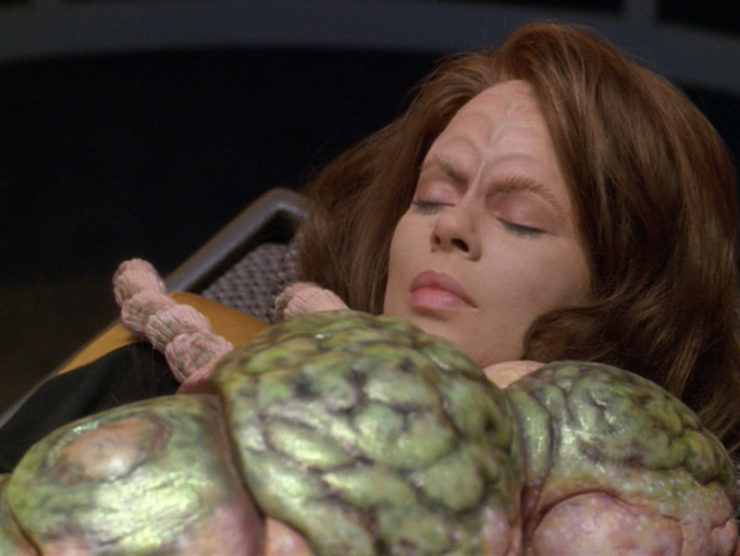
Janeway and Chakotay have been unable to decipher the alien’s signal, but, given that it might be a distress call, she has Tuvok rebroadcast it through the navigational deflector. She also instructs Seven to retrieve the database off the alien’s ship. However, when she and Ensign Tabor attempt to do so, the ship destabilizes and blows up.
Moset and the EMH test a notion on a holographic version of the alien. The EMH is concerned that the procedure Moset suggests will kill the alien, but Moset points out that it may be it or Torres. Then the hologram starts to futz out, and the EMH must take Moset offline.
Kim and Tabor report to sickbay to reconstitute the Moset hologram. Torres wants no part of a Cardassian doctor, but the EMH insists that her innate prejudice against Cardassians is unwarranted. Moset is simply a good doctor.
When Kim and Tabor reactivate the hologram, Tabor nearly goes into hysterics. Moset is a butcher, responsible for the deaths of hundreds of Bajorans. While he is credited with curing the Fostossa Virus, he found that cure by experimenting on Bajorans. Tabor was there, and he saw what Moset did, and two of his victims were Tabor’s grandfather and brother.
Tabor pleads with Chakotay for the hologram to be deleted, and Torres further refuses to be treated by Moset. Seven and Kim do some research, and find evidence that supports Tabor’s accusation, though nothing concrete. Still, the circumstantial evidence is not good.
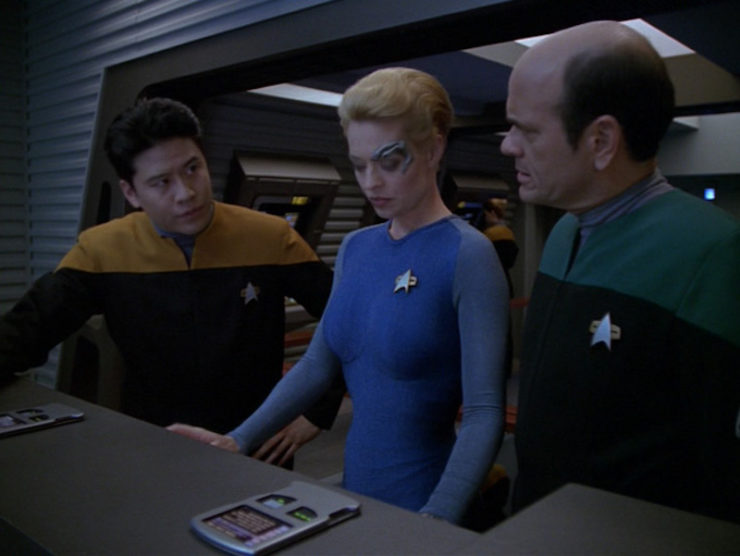
Janeway calls a senior staff meeting. On the one hand, Moset’s treatment is the only thing that the EMH has found that can cure Torres. On the other hand, can they ethically use a method from such a butcher? Finally, Janeway decides to order the EMH to go ahead with the procedure, regardless of Torres’s wishes. They need their chief engineer, and that’s the only yardstick that matters to Janeway.
Another alien ship arrives, of the same configuration as the one that blew up, and sends more incomprehensible signals.
Moset’s treatment very obviously hurts the alien. The EMH hits on a solution that will do less harm to the alien, and it works. The alien detaches itself from Torres and the EMH tells Janeway to beam it to the alien ship. At that, the alien ship moves off.
Torres is royally pissed off at Janeway for disregarding her wishes, and the EMH has to reluctantly get rid of the Moset program even though he could be useful.
Can’t we just reverse the polarity? For four years, the EMH’s database has had all the medical data in the Federation. Now, suddenly, he doesn’t have much on exobiology, even though it’s a subject that had to have come up prior to this.
There’s coffee in that nebula! For the second time, Janeway violates medical ethics and orders a person in her crew to undergo a medical procedure against their will.
Mr. Vulcan. Tuvok hears the alien message before everyone else. Love them ears…
Half and half. Torres has no love for Cardassians, and she’s angry throughout the entire episode at the notion of being treated by one. She isn’t particularly forgiving of Janeway’s going against her wishes, either.
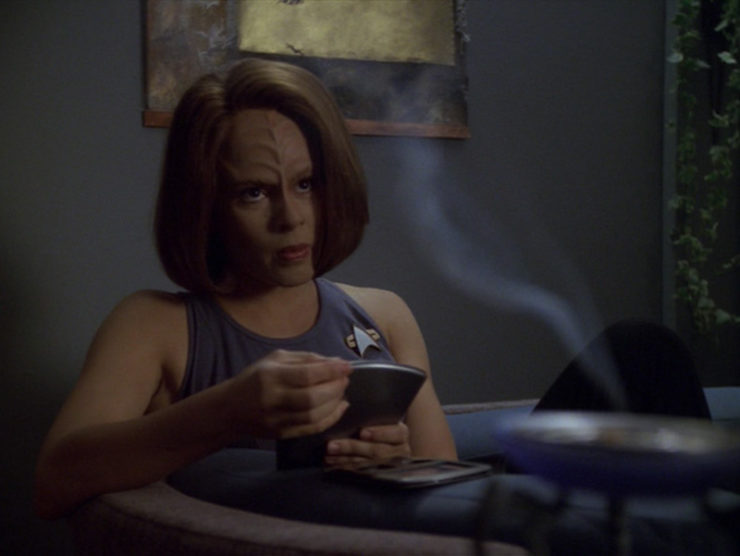
Forever an ensign. Kim points out to the EMH that the Cardassians have long been enemies of the Federation and maybe Moset isn’t the best choice for the consultant’s avatar. For some reason, Kim neglects to mention that the entire reason the Maquis exists is to fight Cardassians, so there may be issues there, too.
Resistance is futile. Despite Torres having an entire staff, including a deputy chief engineer in Joe Carey, Seven is put in charge of engineering while Torres is incapacitated. Sure.
Please state the nature of the medical emergency. The EMH has been showing slideshows to the crew. Chakotay and Kim sat through one showing, and Janeway requested that, when it was time for her, Tuvok, Paris, and Torres to watch it, Chakotay should call for some kind of alert partway through. Chakotay neglects to do so, as he feels his fellow crewmates should enjoy every excruciating nanosecond of the EMH’s stultifying presentation, just as he did.
For Cardassia! Moset ran a hospital on Bajor, ostensibly used to cure the Fostossa Virus, but also used to experiment on Bajorans.
No sex, please, we’re Starfleet. Paris is focused entirely upon curing Torres. He doesn’t leave her side, ostensibly due to his medic training, but mostly because he won’t leave her side no matter what.
What happens on the holodeck stays on the holodeck. Moset’s lab is re-created on the holodeck along with Moset himself.
Do it.
“If the doctor uses knowledge that Moset gained through his experiments, we would be validating his methods, inviting further unethical research.”
“We’d be setting a terrible precedent.”
“We’re in the middle of the Delta Quadrant. Who would know?”
“We would know.”
“Fine. Let’s just deactivate the evil hologram and let B’Elanna die. At least we’d have our morals intact.”
–Tuvok and Chakotay arguing with Paris over what to do.
Welcome aboard. David Clennon plays the hologram of Moset, while Jed Mager makes the first of two appearances as Tabor; Mager will be back in “Repression” in season seven.
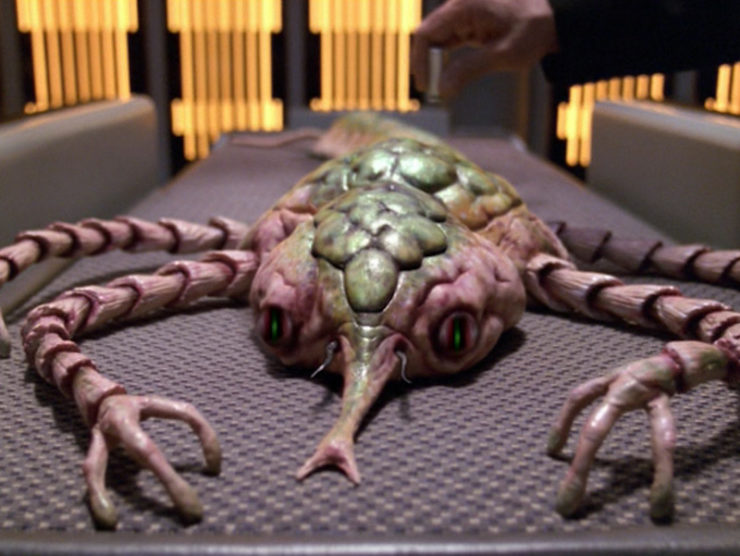
Trivial matters: This is the last Trek writing credit for Jeri Taylor, who had retired from her producing duties after the previous season. She had intended to keep freelancing for the show that she co-created and for which she ran the writers room for four years, but it didn’t happen again after this for whatever reason.
Taylor was one of the creators of the Cardassians, as she wrote the teleplay for “The Wounded,” the TNG episode that introduced them, so it’s kind of fitting that her last script also involved them.
Moset has his origins in the original notion for the DS9 episode “Wrongs Darker than Death or Night,” which was supposed to have a Cardassian doctor who was the equivalent of the Nazi scientist Josef Mengele. The DS9 staff abandoned that aspect, and Taylor picked it up and used it here.
The character of Moset appears in several works of tie-in fiction, including The Battle of Betazed by Charlotte Douglas & Susan Kearny, the Spirit Walk duology by Christie Golden, and the Terok Nor novels Night of the Wolves and Dawn of the Eagles by S.D, Perry & Britta Dennison.
Your humble rewatcher wrote the Mirror Universe version of Moset in The Mirror-Scaled Serpent, part of the Mirror Universe: Shards and Shadows trade paperback, in which Moset was part of a think-tank run by Supervisor B’Elanna of the Klingon-Cardassian Alliance. Dr. Lewis Zimmerman was also part of that think-tank.
By production order, this is actually the one hundredth episode of Voyager, but “Timeless” was always intended to have that slot, and the air dates were rearranged accordingly. This had the unintended side effect of David Livingston directing two straight aired episodes, though this and “Infinite Regress” were filmed three weeks apart.
Set a course for home. “You can’t order someone to get rid of an emotion, Captain.” This episode’s heart is in the right place, but the execution just doesn’t work on any level.
The plot of this story stems from two premises that don’t make a lick of sense. We start with the notion that the EMH has gaps in his database. In more than four years, there’s been no indication of any such gaps, and indeed, he’s boasted about the completeness of his knowledge on more than one occasion. True, it might be hyperbole, but here’s the thing: if there’s any area that he should have complete knowledge of while on a space ship that is likely to encounter a myriad of alien life forms over the course of its regular missions (never mind being stuck in another quadrant), it’s exobiology. Heck, being able to treat Kes and Neelix alone would require some knowledge of it.
But even if we grant this absurd premise, we come to the other one. The EMH gathers all that’s in the ship’s medical database about exobiology and chooses this one Cardassian dude to be the visual referent. We are then asked to accept the notion that this particular avatar can never be changed, and that everything we get from the database given humanoid form is actually from Crell Moset—which is ridiculous. This is supposed to be the sum total of exobiological information the Federation has access to, so the vast majority of what comes out of “Moset’s” mouth wouldn’t be something that originated with Moset, but with one of the other hundreds, thousands, millions of exobiologists in Alpha Quadrant history!
The moment Kim said that the crew likely wouldn’t be comfortable with a Cardassian avatar for this holographic consultant, the first thing the EMH should’ve done was change it to a human or a Vulcan or an Andorian or some other friendly species. It makes no sense on a Federation starship that has a contingent of Maquis to choose to have so provocative a face and personality on the consultant when it’s not necessary.
What’s frustrating is that the moral dilemma posed by the script is a good one. I particularly like that Tuvok is on the side of Torres’ emotional stance, because it is actually rooted in logic.
But the treatment doesn’t come from Crell Moset, it comes from a hologram that happens to look like Moset. Hell, given that the information about Moset’s treatment of Bajorans isn’t entirely public knowledge, it’s impossible to credit that this hologram is anything resembling a reasonable facsimile of Moset’s personality.
It would’ve been so simple to fix this: just have the EMH use a treatment that’s in his database that comes from a Cardassian, and further research reveals that it was from Moset. You can even use an image of Moset as a holographic avatar (in much the same way La Forge used an avatar of Leah Brahms in TNG’s “Booby Trap“), but have the issue be with a preexisting treatment. As it is, we get a treatment that the hologram came up with after examining the alien. That has absolutely nothing to do with Crell Moset.
Jeri Taylor’s career as a Trek writer hasn’t, in my opinion, been sterling, but she’s had some fine moments—notably the creation of the Cardassians in TNG’s “The Wounded,” not to mention some excellent Voyager scripts (“Persistence of Vision,” “Resolutions,” “Hunters,” “One“)—but her swan song is a disaster.
Warp factor rating: 3
Keith R.A. DeCandido will have an essay in BIFF! BAM! EEE-YOW!: The Subterranean Blue Grotto Guide to Batman ’66—Season Two, edited by Jim Beard, with Rich Handley, specifically about “Hizzoner the Penguin”/”Dizzoner the Penguin.” Cover and full table of contents can be found here.










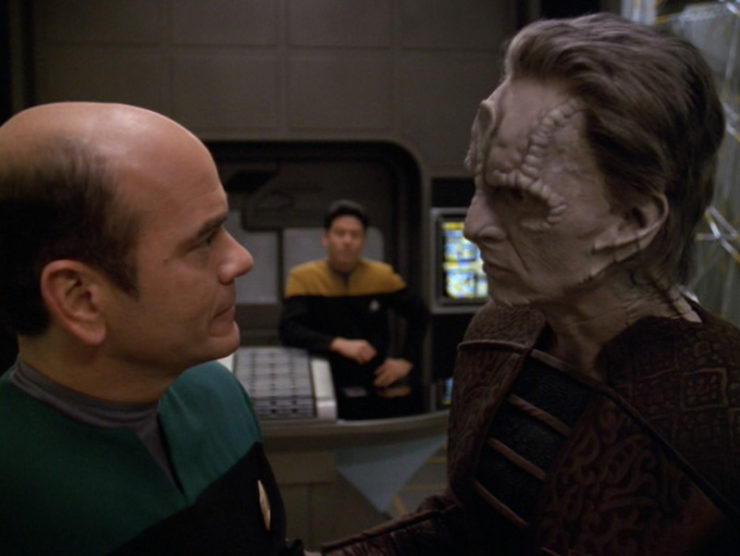
Seriously, what the f*** is up with this? For someone who would rather blow up her ship than let anyone have a replicator, Janeway certainly doesn’t seem to give a good gosh darn about medical ethics of any kind. The minute Torres was awake and able to make a decision that should have been the end of this whole discussion. I get that they are (mostly only theoretically) short on people, but B’Elanna isn’t the only engineer, and Lt. Carey has had 5 years to grow into a potential replacement for her (plus: Seven of Nine has plenty of engineering knowledge). Forcing people to accept experimental medical treatment that they do not want is, well, exactly what Crell Moset did. It isn’t the action of heroes, no matter how many times the show tries to portray Janeway as being right for doing so. Again, this would be easier to swallow if there was literally any follow-up to it whatsoever, but after this B’Elanna will apparently have forgotten all about being forced to undergo a medical experiment concocted based off torture conducted by a Space Nazi. It further irritates me because Janeway is about to do something I find extremely morally questionable next episode, too, and it makes me think that none of the reading they have to do at the Academy covers ethics.
Our hypothetical Emergency Legal Hologram might want to start encouraging the crew to write up living wills.
I don’t think I’ve ever seen this one, but I’m tempted to go watch it now.
But you’re right, the premise doesn’t make sense. If it’s all information that’s already in Voyager’s computer, why can’t the EMH access it directly?
It would almost be more plausible if they’d actually found the real Cardassian had been transported to the Delta Quadrant by sone handwavy means and they were forced to work with him.
It is a good moral question that this episode raises. In the DVD extras Robert Picardo says he disagrees with the decision of the hologram to not use the data again.
Was I the only one who thought Jed Mager was really bad as Tabor? Every line of his felt stilted, somehow. I also didn’t like the contrivance of his confrontation with Moset: the hologram glitchted, which needed a diagnostic, which is done (in part) by Tabor and happens to take place in sickbay. Moset glitching didn’t add anything except for this scene. It all happened because the plot needed it to, and could have been a bit better.
It’s a shame the episode was clunky: I felt the underlying dilemma, of what to do with research gained from, at the very least, questionable practises, a very Star Trek-thing.
A disaster? I couldn’t disagree more. Despite the silly looking creature design, this is one of my favorites.
I feel like this was a DS9 or TNG script that got recycled to be a Voyager script, hence the things that don’t make sense.
If these events took place in the Alpha quadrant, it would be Moset in person that was brought in to consult Bashir/Crusher and provide treatment to Kira/Ro.
THEN we’d have a good story about an ethical dilemma and it would make sense. But since they are in the Delta quadrant, they tried to shoehorn it in using nonsense about an incomplete database and a hologram.
Meh.
Somebody on Facebook pointed something out that I wish I’d said in the rewatch: it makes no sense for the EMH — which is a holographic construct made up of a medical database and a programmed personality to supplement a medical staff — to have to create a holographic construct made up of a medical database and a programmed personality to supplement it.
—Keith R.A. DeCandido
I think I also felt that the episode didn’t quite live up to the promise of its concept — that it was trying to do something meaningful but wasn’t entirely successful in the execution. Still, I didn’t think it was that bad. I think my main problem was that it felt like it belonged earlier in the series, when the Maquis and the Cardassian conflict were still fairly fresh in our memories and the characters’ attention. Also, it would’ve benefitted if Tabor had been established earlier as a recurring character. Pinning so much of the drama on a guest star of the week made it less effective.
It doesn’t bother me so much that the program was only partly based on Moset’s work. I think that underlines the ethical conundrum the episode touched on — it’s hard to separate out knowledge gained from unethical means, since so much of it has been over the generations. So the more the situation blurs the lines, the better it serves the ethical dilemma.
And the hologram was more than just a visual representation. The Doctor wanted a personality matrix that could intelligently interpret the cold, hard data, using the same skills and insight as the real-life genius it was based on. It’s the same expert-program concept behind the Leah Brahms holo in “Booby Trap” — going beyond someone’s published words to a simulation of their thinking process, their unique insight and mindset, their creativity and experience. The exobiology database was what the Moset holo knew, but the Moset personality model determined how it thought. There’s a difference. If it had just been about the raw knowledge, then yes, the Doctor could’ve just studied up himself. What he specifically wanted was another perspective on it, a colleague to bounce ideas off of. That personality model provided advantages that the raw information alone could not, just like, say, Spock could provide Kirk with more insight than just the library computer readout could. So the fact that it was Moset’s personality and point of view was important. It wasn’t just superficial.
As for why the Doctor didn’t have that exobiology information already on call in his own matrix… well, recall that the EMH’s program has gone through a number of disruptions, including a near-total memory loss in “The Swarm.” Part of the reason for that was that his program got too big and ran out of memory. So maybe now he outsources portions of his medical database to the ship’s computer so that he doesn’t get overloaded again.
“I don’t care if he’s the nastiest man that ever lived, as long as he can help us save B’Elanna.”
Oh dear, oh dear, oh dear. This is a mess on just about every level. I can imagine that someone went “Hey, what if we do an episode about medical experiments at concentration camps?” and got a lot of nods of approval, but ultimately it’s a failure on at least two levels. Firstly, the moral they seem to have decided on is “If there’s a known cure for a disease, it should only be used if it was discovered in a way that’s ethically appropriate.” This moral is so dubious that even the episode itself can’t stick to it. So secondly, B’Elanna’s a main titles character, so she has to be saved anyway even if that means accepting the help of the bad Cardassian. This does of course suffer from the fact that the bad Cardassian is thousands of light years away and so we have to accept the conceit that a holographic simulation is somehow responsible for the actions of the person that it’s based on even though it doesn’t remember them, as if the script wandered in from Deep Space Nine and someone had to do an awkward rewrite. (Which, looking at the trivia, I see is almost what happened!)
I was thinking back during the debate on “Tuvix” that this episode seems to see the endgame of Janeway’s belief that her orders supersede individual consent. She manages not to kill anyone this time, but neither does she have the excuse of being an advocate for those who can’t speak for themselves. Whether you agree with B’Elanna’s decision or not, she’s made an informed decision to refuse to consent to treatment, which Janeway and the Doctor override. Maybe it can be justified tactically, since it means keeping a key crewmember alive, but morally it’s very dubious. Yet we have to sit through the closing scenes of Janeway and the Doctor making self-righteous proclamations about how superior they are and how their word is law, while I found myself nodding in agreement with the war criminal pointing out what hypocrites they are.
Janeway putting Seven in charge of engineering with Torres out of action, even though there should be a score of lieutenants and ensigns with more knowledge of Starfleet procedures, is either an example of “The main characters do everything” syndrome, an example of this show’s obsession with giving Seven a large role in an episode that doesn’t really need her to have one, or both. It’s not clear what Tabor is expecting to happen when he tries to resign: Is he going to leave the ship at the next planet or does he expect to stay on board without doing any work?
Oh, and having failed to produce anything remotely resembling a workable replacement EMH back in “Message in a Bottle”, Kim finds it remarkably easy to create an exobiology expert here.
I agree with most of the criticism about the central moral dilemma, but just wish to add my mild surprise that, needing to create a colleague with a slightly different specialty than himself, the EMH did not choose to model it’s avatar on Robert Picardo.
There was a Babylon 5 episode that did something similar with the question of whether it was ethical to benefit from medical advances gained through mass atrocity, ohg V guvax va gung pnfr gur zrqvpny nqinaprzrag vgfrys erdhverq batbvat harguvpny gerngzrag. Fbzrguvat yvxr orvat noyr gb tnva vzzbegnyvgl ohg bayl ol xvyyvat nabgure crefba.